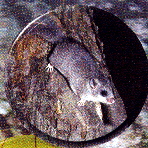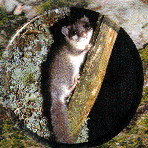





Contribution by Dr. Rimvydas Juškaitis ©: Institute of Ecology, Akademijos 2, LT-2600 Vilnius, Lithuania
Three dormouse species are included in the Red Data book of Lithuania (1992): the fat dormouse (Glis glis) and the forest dormouse (Dryomys nitedula) in the 3rd category (rare species), and the garden dormouse (Eliomys quercinus) in the 4th category (indeterminate species). The fourth dormice species - the common dormouse (Muscardinus avellanarius) - is quite common and widespread in Lithuania.
Until 1990 the status of rare dormouse species was completely unclear in Lithuania: only four old localities for fat dormouse, forest dormouse and garden dormouse were known. The exact location and present status were indeterminate. In 1990-1993 six new localities for the fat dormouse and one for the forest dormouse were discovered in Lithuania.
In 1997-1998 "Fauna & Flora International" (Great Britain) supported the project "Distribution of rare dormouse species in Lithuania". The purpose of this project was to discover new, still unknown, areas where these dormice occurred in order to take necessary measures for their conservation.
For this purpose, 200 wooden nestboxes with the internal dimensions of 14 x 14 x 28 cm and an entrance hole diameter of 45 mm were produced. 20 nest-boxes were established in 10 potential rare dormouse dwelling places in April - May 1997. In all 10 localities the nestboxes were checked in September 1997 and September 1998.
Using nestboxes for discovering dormice proved successful. Fat dormice were found in two localities and common dormice in four localities. The two new localities for the fat dormouse are the seventh and eighth recorded areas for this species known in Lithuania at the present time.
Although the results of the project seem appear quite modest, they do show the real situation and status of the rare dormouse species in Lithuania. The assumption was confirmed that, except for the common dormouse,the three other species are really rare in Lithuania.
The fat dormouse is the most abundant of the three rare dormouse species: eight localities are known in Lithuania now. The results of the project confirmed the earlier idea that all known localities for the fat dormouse are situated in forests near the Nemunas and Neris rivers. Probably it now occurs in isolated separate parts of the formerly big population. The importance of small streams flowing into Nemunas and Neris rivers came to light: two new localities for fat dormouse were found in stream valleys. The animals probably also occur in a few other forests near these two biggest Lithuanian rivers and in the valleys of their tributaries. There is a slight probability that these dormice also occur in in other parts of Lithuania.
Glis glis is extinct in two old localities and probably in some localities recently investigated due to the cutting of forests and other anthropogenic impact. Cutting of mature forest, particularly oak-woods, leads to the shortage of old hollow trees and suitable plant food for the fat dormouse.
It is not clear whether the garden dormouse still lives in Lithuania. The only records of this species are from Perloja forestry (South Lithuania) (1957-1959) and the exact location remains unknown. To present the garden dormouse has not been found in this forestry, even following special investigations. The garden dormouse has been declining throughout the Baltic states for unknown reasons during recent decades (Airapetjanc, 1983; Pilats, 1994).
There is currently only one known population of the forest dormouse in south-west Lithuania. Lithuania and Latvia lie on the northern border of the species' distribution area, so the animal is likely to be rare here.
The majority of localities in Lithuania where the fat dormouse occurs are in protected areas. Three zoological reserves were established specially for the protection of this species in Lithuania.
Strosiunai theriological reserve
Rumsiskes theriological reserve
Semeniukai zoological reserve / Neris regional park
Contact: Dr. Rimvydas Juškaitis: Institute of Ecology, Akademijos 2, LT-2600 Vilnius, Lithuania






Photos © Rimvydas Juškaitis